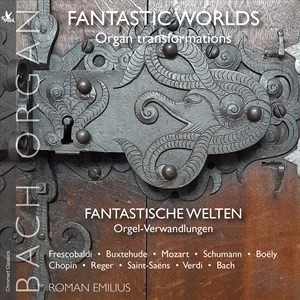

Girolamo Frescobaldi (1583-1643: Toccata prima (Book 2) Dietrich Buxtehude (1637-1707): Prelude in G Minor, BuxWV 148 Wolfgang Amadeus Mozart (1756-1791): Fantasie - Adagio and Allegro in F Minor, K. 594 Robert Schumann (1810-1856): 12 Klavierstücke, Op. 85: No. 2. Bärentanz (arr. R. Emilius for organ) Robert Schumann (1810-1856): Albumblätter, Op. 124: No. 16. Schlummerlied (arr. W.T. Best for organ) Alexandre Pierre François Boëly (1785-1858): Fantasia and Fugue in B-Flat Major Frédéric Chopin (1810-1849): Nocturne No. 15 in F Minor, Op. 55, No. 1 (arr. W. Faulkes for organ) Max Reger (1873-1916): Prelude in E Minor, Op. 69, No. 1 Max Reger (1873-1916): Aus tiefer Not schrei ich zu dir, Op. 67, No. 3 Max Reger (1873-1916): Fugue in E Minor, Op. 69, No. 2 Camille Saint-Saëns (1835-1921): Fantasy in C Major, Op. 157 Giuseppe Verdi (1813-1901): Falstaff: Menuet (arr. R. Emilius for organ) Johann Sebastian Bach (1685-1750): Air, "Air on the G String" (arr. P. Gordon for organ)
A highly diverse and fascinating collection of pieces performed by organist and cantor Roman Emilius on the magnificent 2020 Ahrend organ of the Trinity Church in Regensburg. An instrument designed by Roman Emilius in collaboration with a panel of experts. It's dubbed the "Bach Organ" because of the baroque organ-building practices of central Germany applied during its conception.
As you can see from the list of titles listed above, the music spans well over 300 years and covers everything from original organ works, to piano pieces, and even something drawn from the world of opera.
The following text from the booklet notes best describes the concept behind this recording: "The organ, as an instrument of the church, has to transform itself for this because anything too human was to be kept out of the church. That is why this CD is subtitled "Organ Transformations". "Stylus phantasticus" was the name given in the 17th century to a style of music that called for boundaries to be crossed and rules to be broken in favor of increasing expressiveness. This goes hand in hand with freedom of presentation."
Most stunning is how Roman Emilius adapts the various organ stops to create a just registration befitting the character of each and every piece. A primary, primitive sound spectrum applied to the Renaissance era of Frescobaldi. The apt use of the 16' Bassoon stop to represent the bear in Schumann's Bärentanz taken from the collection "piano pieces for small and big children, Op. 85". The subdued character of the Chopin Nocturne. The bold and clear baroque sound of the Buxtehude. This perfectly designed pipe organ certainly demonstrates its versatility and flexibility within this recording.
The proverbial icing on the cake in this case is a leisurely paced and tonally pure interpretation of one of the most admired pieces of the Baroque era, the Air from Bach's Orchestral Suite No. 3, which harmoniously caps the program.
Jean-Yves Duperron - November 2024 Schumann - BärentanzBach - Air